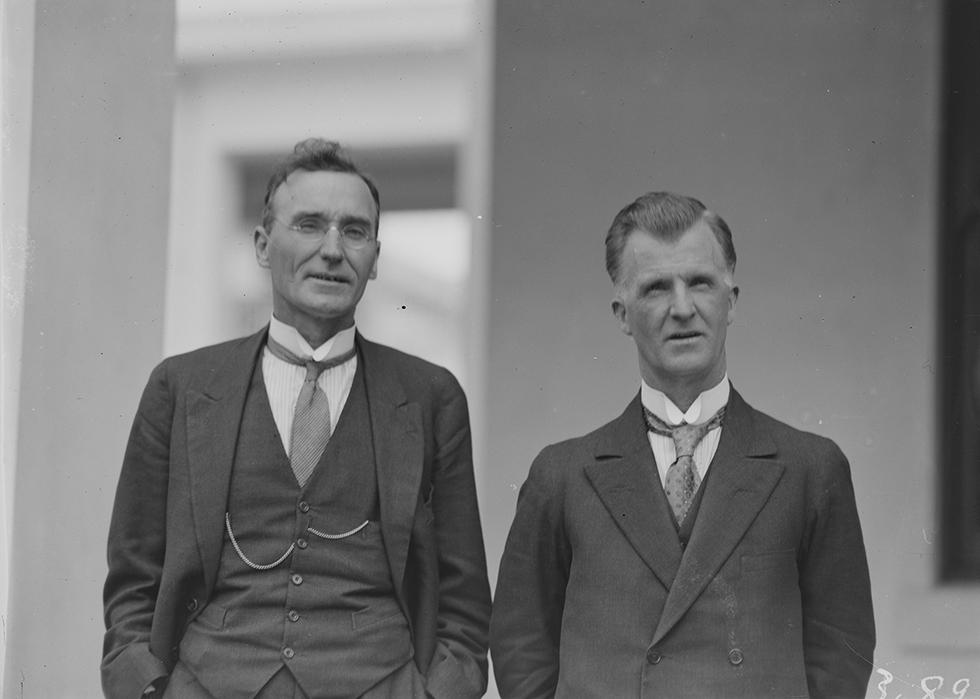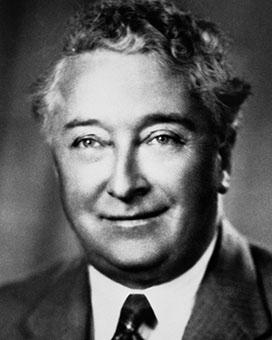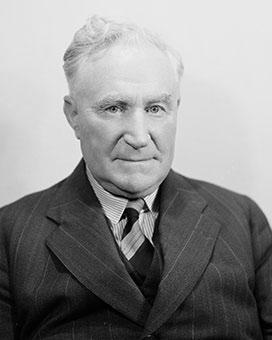James Henry Scullin was born on 18 September 1876. He was the 5th of 9 children of Irish immigrants Ann Logan and John Scullin. He went to the local school at Trawalla, Victoria, and then to the Mount Rowan school near Ballarat.
By the time he was 14, he had left school and worked first in a grocer’s, then, during the 1890s depression years, at any job he could find in mines and on farms. At night and on weekends, he studied at evening classes and in public libraries.

‘Politics held a special fascination for him’ – 25 years a Labor man, in 1928, James Scullin became leader of the federal parliamentary party. Scullin (right) and Arthur Blakeley his deputy. NAA: A3560, 3896
About 1900, Scullin found a job managing a small grocery in Ballarat. He made the most of everything Ballarat had to offer – the public library, the vibrant South Street debating society, and the meetings and guest speakers of the Australian Natives Association. He was also a regular at the study groups of the Catholic Young Men's Society, where he developed a thorough knowledge of the Rerum novarum, the powerful social justice encyclical issued by Pope Leo in the 1890s.
A man of energy and drive, Scullin was a talented debater and had a keen interest in politics. In 1903, he joined the new Political Labor Council, which became the local branch of the Australian Labor Party. Still a grocer 3 years later, he was also an organiser for the Australian Workers Union, setting up branches of the Political Labor Council throughout western Victoria. His colleagues included British socialist Tom Mann, who had set up the Ballarat branch in 1903, and John Curtin, like Scullin, born and raised in the Ballarat area.
Labor politics 1906–22
In 1906, Scullin (now 30 years old), stood as a candidate for the Ballaarat seat in the December 1906 election for the House of Representatives. Although assisted in his campaign by visiting British Labour politician Ramsay Macdonald, Scullin nevertheless lost to sitting member and Prime Minister, Alfred Deakin.
In the next federal election in 1910, Scullin won the seat of Corangamite and was part of the Labor landslide that made Andrew Fisher Prime Minister. He was also part of the defeat when, at the next election in 1913, Joseph Cook replaced Fisher as Prime Minister, and Scullin lost Corangamite. Scullin spent the next 8 years as editor of the Evening Echo in Ballarat, Labor’s daily newspaper.
These were turbulent years in Labor politics – Andrew Fisher led Labor back into office in 1914, only to be replaced by WM Hughes as Labor leader the next year. When the Labor party split over conscription, Scullin was among those campaigning against the Hughes government referendums in 1916 and 1917. At Labor’s December 1916 conference, Scullin moved to expel supporters of conscription, including Prime Minister William Hughes and former Prime Minister Chris Watson. Hughes remained in government by forming a Nationalist ministry, and Labor’s new leader, Frank Tudor, became Leader of the Opposition.
Preferential voting was introduced before the 1918 election when Scullin again stood for Corangamite. Although he won the most votes outright, after preferences were distributed, the seat went to the Farmers Union candidate, William Gibson.
After a term as state president of the Labor Party (1918–19) and an unsuccessful attempt to win a seat in the Victorian parliament in 1920, Scullin was a major force behind Labor’s adoption of the socialisation objective at the 1921 conference. When Frank Tudor died suddenly in 1922, Scullin was selected to contest the by-election for the seat of Yarra.
Member for Yarra 1923
After a 10-year gap, Scullin again became a Member of the House of Representatives in 1923. He retained his seat until he retired in 1949. He was not among the more radical Labor members in the federal parliament on all issues, but supported the key 1921 socialist objectives. Although consistently opposed to compulsory enlistment, Scullin was neither an unwavering pacifist like Frank Brennan, nor a militant Irish nationalist like Hugh Mahon, expelled from the House of Representatives on 11 November 1920 for having attacked British policy at a public meeting in Melbourne. Scullin had long been an advocate of Irish ‘Home Rule’. He was among those opponents of British policy in Ireland during the Anglo–Irish war (1919–21) who were dismayed by the internal conflict which followed the establishment of the Irish Free State in 1922.
Although no longer the promising youth who had first entered the House in 1910, Scullin was just as determined and hardworking. He and Sarah Scullin were prompt in taking up the opportunity to visit the site of the national capital. They stayed at Yarralumla – a VIP hostel before it became Government House when the seat of government was moved to Canberra in 1927.
On 26 April 1928, Scullin was elected leader of the federal parliamentary Labor Party. At the election in November that year, among the 31 seats won by Labor were Macquarie and Fremantle, bringing Ben Chifley and John Curtin into parliament. In October 1929, Labor won government in a landslide victory of 46 seats, and James Scullin became the first Irish-Australian prime minister.
Sources
- Faulkner, John and Stuart McIntyre (eds), True Believers: The Story of the Federal Parliamentary Labor Party, Allen & Unwin, Sydney, 2001.
- Robertson, John, JH Scullin: A Political Biography, University of Western Australia Press, Perth, 1975.
From the National Archives of Australia collection
- Visit of Mr and Mrs Scullin, 1923, NAA: A361, DSG23/2723





